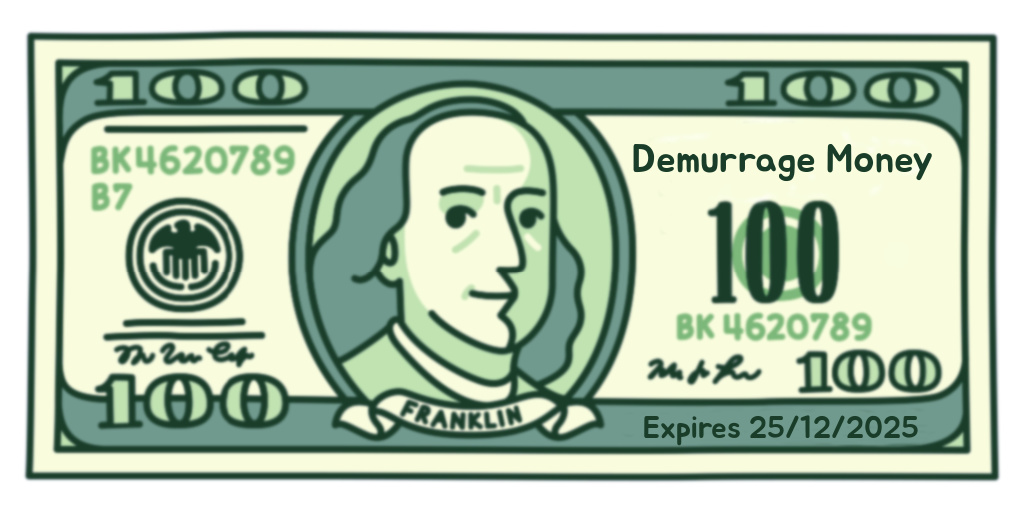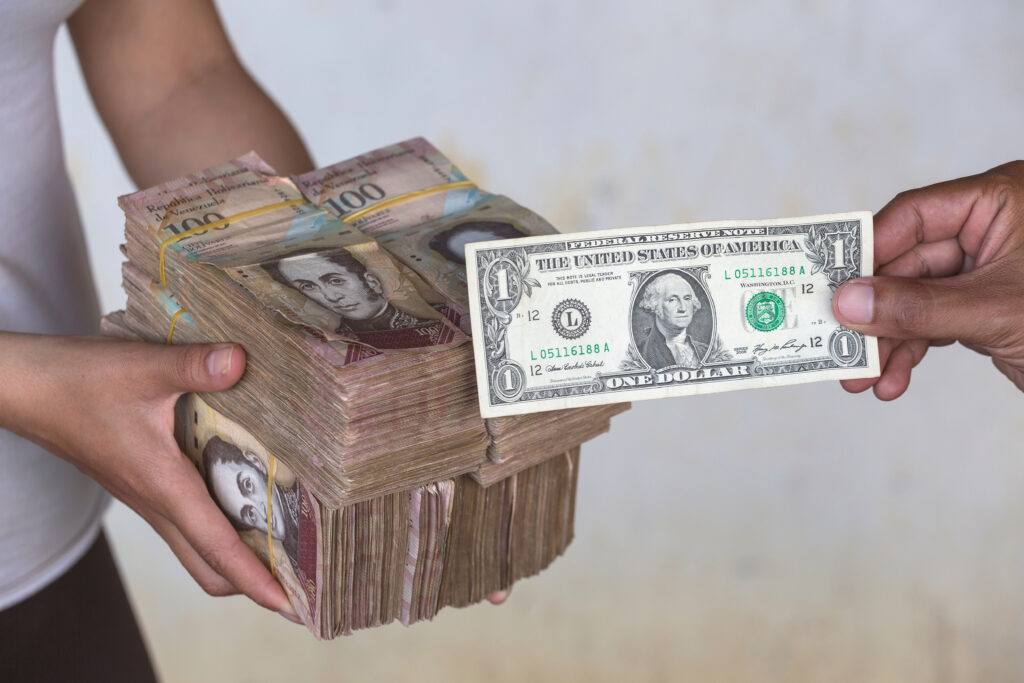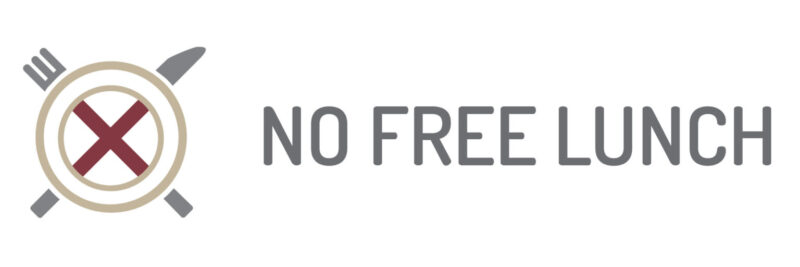How would you feel if your money had an expiry date like the milk in your fridge? Money with a use-by date, aka demurrage currency, might seem nuts, but the idea dates back to ancient Egypt and could soon be revived as part of new national digital currencies coming to a central bank near you.

The concept of money with an expiry date might sound like part of a Black Mirror plot, but demurrage currency can be traced back to ancient Egypt. It was also practised in parts of Medieval Europe and, thanks to the writing of an Argentine economist, trialled in Austria in the 1930s.
Though the idea of decaying money has remained borderline heretical by mainstream economists, demurrage currency might make a surprising and controversial comeback thanks to the emergence of digital currencies.
What is demurrage currency?
Demurrage currency is money that incurs a fee or expires if it isn’t spent by a specific date.
The term demurrage is more widely used within shipping to describe the cost imposed for the delay in loading/unloading a vessel, borrowing from the Latin root demurari – to tarry or delay.
The idea of demurrage currency, money that incurs a regular fee when its spending is delayed, was popularised by a German Argentinian economist called Silvio Gesell in his 1906 book The Natural Economic Order.
Gesell was a proponent of money solely as a medium of exchange, i.e. facilitating economic activity. He viewed money’s function as a store of value as beneficial to the holder but detrimental to broader economic activity and social equity; he aimed to discourage hoarding by applying a monthly fee to retain money.
Ostraca and the origins of demurrage currency
Gesell intended to improve the function of money by charging savers to keep funds idle, but he was simply borrowing an idea from one of history’s strangest forms of money; Egyptian ostraca.
Ostraca were multi-purpose notes etched on limestone flakes, serving as everything from cartoon-like images to to-do lists but also as a storage receipt.
A farmer without his own storage facilities would take his produce to a grain store, receiving an ostraca detailing his deposit. On redemption, the farmer could cart off his wheat or barley minus a portion as payment to the storage facility’s owner for protecting his goods from vermin, dampness or thieves.
In the context of grain storage, ostraca was a forerunner to shipping demurrage, but these limestone tokens also served as money for local trading, so that time-based storage charge might have been passed on, a bit like a hot potato, establishing an early form of decaying money.
Brakteaten & demurrage money
And though similar forms of proto-money existed in places like Sumeria – where clay tablets similar to ostraca survive – the concept of decaying money didn’t re-emerge until around the 12th century in Medieval Europe, through Brakteaten.
Brakteaten was a localised coinage system used for trade and required for tax collection, which was periodically recalled and devalued, disincentivising hoarding and promoting exchange.
Gesell was clearly a monetary historian, reviving the ideas embodied with ostraca and brakteaten in what he described as demurrage currency, money that, when not being used, should decay or ‘rot like potatoes’.
“Our worthy experts when considering the currency question forgot the goods – for the exchange of which the currency exists. They improved money exclusively from the point of view of the holder, with the result that it became worthless as a medium of exchange… as Proudhon put it, they forged “a bolt instead of a key for the gates of the market”.
The Natural Economic Order – Silvio Gisell
Fiat Money – a bolt instead of a key
What Gesell was essentially suggesting through demurrage currency was changing our fundamental perspective of money.
His intent was to put money on par with other perishable goods, decaying like natural commodities and breaking the quality of durability that Aristotle proposed as one of the five key attributes that make money useful.
More than a century ago, Gesell put his finger on our irrational obsession with possessing money because of an intrinsic value we put on it, above and beyond its functional use as a tool for moving our labour through space and time.
But try telling the estimated 2,700 billionaires worldwide that they need to pay for the privilege of treating their wealth as a store of value; you’d get a predictable response.
Surprisingly, Gesell’s demurrage currency was actually tried in the wild in a small Austrian town called Worgl. Unsurprisingly, the context was hyperinflation experienced in Austria and Germany during the interwar years, where a complex set of socio-economic factors saw the failure of money as an effective medium of exchange or store of value.
The Worgl experiment created a new form of money, a Work Certificate, which required a one-penny monthly stamp to be applied to its reverse.
Applying an explicit cost to retain this new form of money encouraged holders to spend it quickly or ensure that the purpose they were saving it for justified the cost of delayed gratification.
The scheme ran for 14 months but was eventually shut down by authorities after pressure from the banks.
The early 2000s saw experiments in Europe with community currencies, such as the Bristol Pound, which wasn’t legal tender but functioned as money and had an expiry date. Unfortunately, none of these localised currencies survived.
Ironically, the ‘Miracle of Wogl’ and Bristol Pound might soon become part of a new mainstream monetary toolkit used by central banks – Central Bank Digital Currencies (CBDCs).
How CBDCs enable customisable demurrage currency
Central Bank Digital Currencies are a hybrid monetary system using elements of distributed ledger technology employed by cryptocurrencies like Bitcoin but retaining compatibility with traditional central bank control.
So, from the government’s perspective, CDBCs deliver efficiencies in terms of:
- knowing how and where money is being used
- the speed with which money can be moved & applied
- the ability to customise how and when money is used based on the recipient, such as applying expiry dates, reviving the idea of demurrage
CBDC’s ability to program how money works based on specific recipients is perhaps what has flipped the perception of demurrage in the eyes of authorities. Blanket use would be politically unthinkable, but it may become a flexible policy tool applicable on a case-by-case basis.
Social benefits already exist with terms attached known as non-cash vouchers, which in the UK are offered for everything from childcare to groceries and domestic energy bills.
Digital national currencies offer the potential for these existing criteria to apply, so a use-by-date would be a natural policy extension, though representing a significant and controversial step towards surveillance capitalism.
Aside from the direct application, which CBDCs make possible, there are less explicit ways of producing decaying money, such as hyperinflation.
Hyperinflation – the cost of holding failing money
Hyperinflation creates unintentional demurrage currency. When Venezuelans get paid in Bolivar, it’s a race against time to spend or exchange it as quickly as possible before it devalues. Goods in the supermarket can become more expensive – priced in Bolivar – between the shelf and the cashier.
Runaway inflation creates an implied cost on holding money, demurrage currency by the backdoor, resulting from monetary failure. But even developed and relatively stable Western economies have started applying a monetary policy that amounts to demurrage – negative interest rates.

Negative interest rates – demurrage by another name
The strange economic times that followed the 2008 financial crisis have seen central banks desperately trying to generate growth using familiar levers – expanding liquidity and reducing interest rates.
But hit by both Covid and macroeconomic shocks – supply issues and rocketing energy prices – interest rates were cut to the bone, yet didn’t achieve the desired results, so the European Central Bank (among others) took the perverse step of applying a negative interest rate of -0.5%.
Charging depositors for the privilege of holding money with the ECB sounds like demurrage currency. It certainly has the same objective – incentivise cash holders to deploy their funds in the economy rather than letting them sit idle in an account.
Demurrage money & new economic thinking
For renegade economist Kate Raworth, paying to park your money is one way to build a more equal and sustainable economy. Echoing some of Gesell’s thinking, Raworth sees our focus on accumulating money as a cause of global economic inequality and environmental degradation. Her solution? Demurrage, via electronic currency, as outlined in her book ‘Doughnut Economics: Seven Ways to Think Like a 21st-Century Economist’.
What kind of currency, then, could be aligned with the living world so that it promoted regenerative investments rather than pursuing endless accumulation? One possibility is a currency bearing demurrage, a small fee incurred for holding money, so that it tends to lose rather than gain in value the longer it is held.
Doughnut Economics: Seven Ways to Think Like a 21st-Century Economist’.
Raworth’s highly acclaimed book was written in 2017, a little before the development of Central Bank Digital Currencies (CBDCs), which 130 central banks are now trialling.
Paradoxically, those within the crypto community focused on decentralisation, self-sovereignty, and privacy see CBDCs as the antithesis of progressive economics and instead a tool of surveillance capitalism, a perception supported by China’s enthusiastic embrace of the idea.
Raworth doesn’t appear to have commented on whether she views CBDCs as the natural means to apply demurrage or whether she’d prefer a truly decentralised blockchain to program the cost of holding money. Interestingly, demurrage doesn’t feature in the tokenomics of any notable cryptocurrency.
Whether the ideas of the left and right on demurrage currency are meeting, horseshoe style, or propose radically different interpretations remains to be seen. Semantics are likely to play a big part; expect to see terms like ‘circular incentive’ used rather than ‘decaying money’.
Whatever the label and potential societal benefits of attaching a cost to holding money, demurrage currency will be a hard sell.
Forcing the use of currency that holders know will lose value would inevitably push investors to seek alternate stores of value. We know this from Gresham’s Law established in the 16th century, but there’s physical evidence dating back much further that shows our desire to preserve value.
Shell necklaces found in caves in South Africa, dating back over 75,000 years, show humans have an innate desire to store value into the future that will prove very difficult to break.
FAQs
Demurrage describes a few paid in the shipping industry for delaying the loading or unloading of a vessel, borrowing from the Latin root demurari – to tarry or delay.
Demurrage currency is money that incurs a fee, or expires, if it isn’t spent by a specific date. The concept was popularised by Silvio Gesell’s 1906 book The Natural Economic Order, but there is evidence demurrage money was used in parts of Medieval Europe.
No Free Lunch
There is no such thing as a free lunch, but if you’re hungry to find out why, we’re here to help.
You can learn the meaning and origin of the no free lunch concept, as well as the broader philosophy behind the idea that nothing can ever be regarded as free.
We look at our relationship with money and truth, examining all of the supposed shortcuts, life hacks and get-rich-quick schemes.
